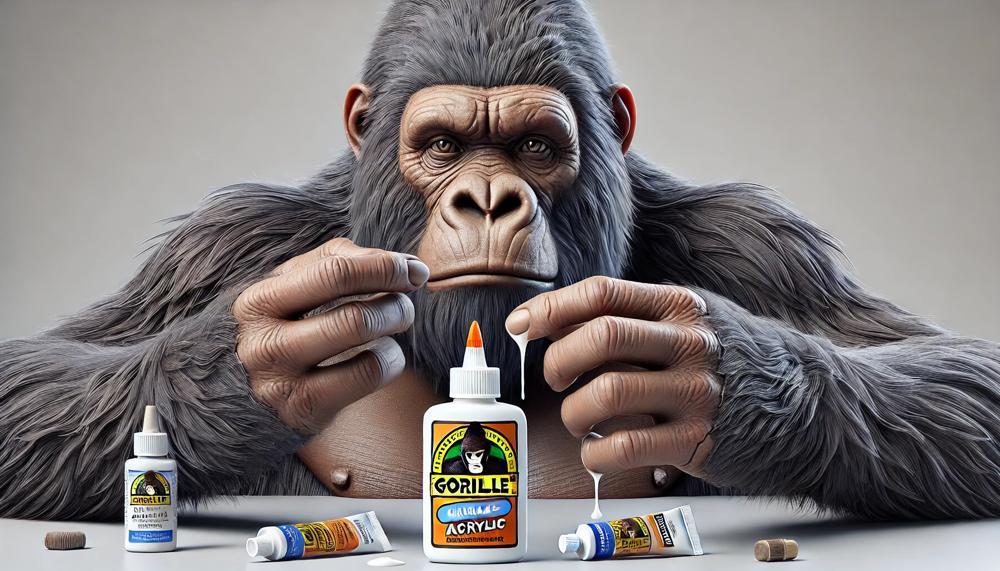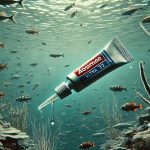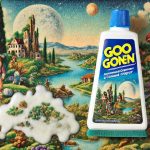The Short Answer is Yes…but There’s a Catch.
If you’re working on a project involving acrylic and need a strong adhesive, Gorilla Glue can get the job done – with a few important caveats. Here are the key points to keep in mind:
- Gorilla Glue will bond to acrylic, but it expands quite a bit as it cures
- For a smooth finish, use as little glue as possible and clamp pieces tightly
- The expansion can cause cracks or warping in thin acrylic pieces
- Consider using a two-part epoxy or acrylic cement adhesive instead for delicate applications
From furniture to displays to DIY projects, acrylic is extremely versatile. But adhering it properly is critical to ensure your hard work doesn’t end up as a cracked, sticky mess. Read on as we dive into the best glue options and techniques for bonding this unique plastic material.
Table of Contents
Where to buy plexiglass glue
The choice of adhesive depends on the intended application and the materials being joined. Here are some options for purchasing plexiglass glue suitable for use with acrylic:
| Adhesive Type | Recommended Products | Where to Buy |
| Acrylic-based adhesives |
|
|
| Cyanoacrylate (super glue) |
|
|
| Epoxy adhesives |
|
|
Where can i buy acrylic glue

| For your DIY acrylic projects, you can effortlessly procure acrylic glue from various sources: | Craft stores like Michaels and Hobby Lobby offer a diverse selection of acrylic adhesives and UV resins suitable for bonding clear or translucent acrylic sheets. | Online retailers such as Amazon and Dick Blick Art Materials provide a convenient option to purchase specialized acrylic glues and UV resins tailored for your DIY needs. |
| For opaque acrylic bonding, seek out Weld-On adhesives, available at hardware stores like Home Depot or Lowe’s, as well as online vendors specializing in plastics and adhesives. | Many art and craft supply websites, such as Sculpt.com and Utrecht Art Supplies, offer a diverse range of acrylic glues and UV resins tailored for artists and DIY enthusiasts. | Local craft or hobby stores in your area may also carry a selection of acrylic adhesives, allowing you to inspect the products in person before making a purchase. |
| By exploring these various outlets, you’re bound to find the perfect acrylic glue to suit your DIY project needs, whether you require a clear adhesive for transparent materials or a specialized bonding agent for opaque acrylic surfaces. | ||
What glue sticks to acrylic
For bonding acrylic materials, solvent cement is widely considered the optimal adhesive choice. This specialized glue forms an exceptionally sturdy and long-lasting bond by chemically melting and fusing the acrylic surfaces together. When applied correctly, solvent cement creates a virtually seamless and transparent joint, making it ideal for acrylic fabrication and repair projects.
Solvent cement is designed specifically for bonding acrylic (also known as poly(methyl methacrylate) or PMMA) to itself. It contains solvents that temporarily dissolve the acrylic surfaces, allowing them to intermingle and fuse upon curing. This chemical welding process results in a bond that is often stronger than the acrylic itself.
Major advantages of using solvent cement for acrylic bonding include its exceptional strength, clarity, and resistance to moisture, chemicals, and temperature fluctuations. It is also relatively inexpensive and easy to apply, making it a popular choice among professionals and DIY enthusiasts alike.
However, it’s crucial to follow the manufacturer’s instructions carefully, as solvent cement requires proper surface preparation, application techniques, and curing time. Improper use can lead to weak or failed bonds, crazing (small cracks), or stress cracking of the acrylic.
While solvent cement is the preferred choice for most acrylic bonding applications, there are alternative adhesives that can be used in certain situations. For example, cyanoacrylate (super glue) or two-part acrylic adhesives may be suitable for small repairs or low-stress applications, but they generally do not provide the same level of strength and durability as solvent cement.
When selecting an adhesive for acrylic, it’s essential to consider the specific project requirements, such as the desired bond strength, clarity, and environmental conditions. Consulting with professionals or referring to trusted resources like TAP Plastics can help ensure the appropriate choice and application method for achieving a successful and long-lasting acrylic bond.
Glue Gorilla
Gorilla Glue is a versatile and potent adhesive renowned for its exceptional bonding capabilities. However, when it comes to acrylic surfaces, exercising caution is paramount. While Gorilla Glue can adhere to acrylic, its strength can be detrimental, especially if the acrylic is engraved from the back.
| Gorilla Glue | Suitable for Acrylic? | Precautions |
| A high-strength polyurethane adhesive in a gel form with a green lid. | Yes, but with caution. | Avoid using on engraved acrylic surfaces, as it can destroy the engraving. |
| Renowned for its versatility and superior bonding capabilities. | Suitable for non-engraved acrylic surfaces. | If accidentally bonded to engraved acrylic, carefully pry the pieces apart to prevent damage. |
The potency of Gorilla Glue can be a double-edged sword when working with acrylic. While it can form a robust bond, its strength can also lead to the destruction of intricate engravings on the back of acrylic surfaces, potentially ruining a project you’ve invested significant time and effort into.
To mitigate risks, it’s advisable to exercise caution and consider alternative adhesives specifically designed for acrylic, such as solvent cements, which offer exceptional bonding strength while preserving the integrity of the acrylic surface. If you inadvertently bond engraved acrylic with Gorilla Glue, gently prying the pieces apart may be the only solution to prevent irreparable damage.
Ultimately, the decision to use Gorilla Glue on acrylic surfaces hinges on the specific project requirements and the level of risk you’re willing to accept.
Conclusion
While Gorilla Glue can technically bond to acrylic surfaces, exercising caution is paramount. This industrial-strength adhesive expands significantly as it cures, potentially causing cracks or warping in thin acrylic pieces. For delicate applications or projects involving engraved details, consider opting for specialized acrylic cements or two-part epoxy adhesives instead. These alternatives offer a secure bond while minimizing the risk of damaging your acrylic workpiece.
If you decide to use Gorilla Glue, apply it sparingly and clamp the pieces tightly to ensure a smooth finish. The expansion during curing can mar the appearance or integrity of your project if not properly constrained. For opaque, non-engraved acrylic, Gorilla Glue may be a viable option, but for transparent or intricately detailed pieces, it’s best to err on the side of caution.
Ultimately, the choice of adhesive depends on the specific requirements of your acrylic project. Solvent-based acrylic cements provide exceptional clarity and strength but require careful surface preparation. Cyanoacrylates offer convenience for small repairs, while epoxies excel in bonding dissimilar materials.






